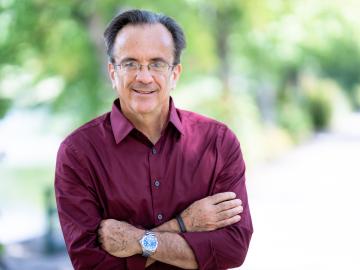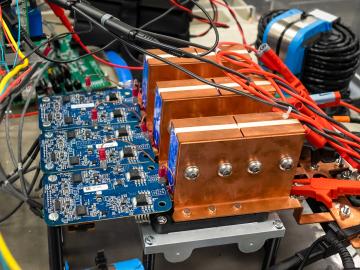
Filter News
Area of Research
- Advanced Manufacturing (1)
- Biology and Environment (5)
- Computational Engineering (1)
- Computer Science (3)
- Electricity and Smart Grid (1)
- Energy Science (27)
- Fusion and Fission (9)
- Fusion Energy (2)
- Isotopes (2)
- Materials (9)
- Materials for Computing (11)
- National Security (3)
- Neutron Science (7)
- Quantum information Science (3)
- Sensors and Controls (1)
- Supercomputing (14)
- Transportation Systems (1)
News Topics
- (-) Cybersecurity (5)
- (-) Fusion (20)
- (-) Grid (26)
- (-) Machine Learning (24)
- (-) Nanotechnology (12)
- (-) Polymers (10)
- (-) Quantum Science (34)
- (-) Space Exploration (7)
- (-) Summit (23)
- (-) Transportation (36)
- 3-D Printing/Advanced Manufacturing (56)
- Advanced Reactors (7)
- Artificial Intelligence (52)
- Big Data (33)
- Bioenergy (29)
- Biology (45)
- Biomedical (23)
- Biotechnology (15)
- Buildings (42)
- Chemical Sciences (37)
- Clean Water (14)
- Composites (17)
- Computer Science (76)
- Coronavirus (10)
- Critical Materials (11)
- Education (2)
- Emergency (3)
- Energy Storage (36)
- Environment (77)
- Exascale Computing (27)
- Fossil Energy (4)
- Frontier (25)
- High-Performance Computing (64)
- Hydropower (1)
- Isotopes (29)
- ITER (6)
- Materials (56)
- Materials Science (48)
- Mathematics (8)
- Mercury (3)
- Microelectronics (2)
- Microscopy (14)
- Molten Salt (1)
- National Security (41)
- Neutron Science (43)
- Nuclear Energy (21)
- Partnerships (29)
- Physics (12)
- Quantum Computing (25)
- Security (11)
- Simulation (24)
- Statistics (4)
Media Contacts

Oak Ridge National Laboratory researchers have created a technology that more realistically emulates user activities to improve cyber testbeds and ultimately prevent cyberattacks.

Oak Ridge National Laboratory researchers developed and demonstrated algorithm-based controls for a hybrid electric bus that yielded up to 30% energy savings compared with existing controls.

Staff at Oak Ridge National Laboratory organized transport for a powerful component that is critical to the world’s largest experiment, the international ITER project.

A team led by the ORNL has found a rare quantum material in which electrons move in coordinated ways, essentially “dancing.”

The daily traffic congestion along the streets and interstate lanes of Chattanooga could be headed the way of the horse and buggy with help from ORNL researchers.

Diego Del-Castillo-Negrete, a distinguished staff member in the Fusion Energy Division, was cited for Outstanding Technical Achievement – National Laboratory. He will be recognized during the GMiS annual conference, which will be held virtually Oct. 11-22. The HENAAC awards program is in its 33rd year.

Of the $61 million recently announced by the U.S. Department of Energy for quantum information science studies, $17.5 million will fund research at DOE’s Oak Ridge National Laboratory. These projects will help build the foundation for the quantum internet, advance quantum entanglement capabilities — which involve sharing information through paired particles of light called photons — and develop next-generation quantum sensors.

Pengfei Cao, a polymer chemist at ORNL, has been chosen to receive a 2021 Young Investigator Award from the Polymeric Materials: Science and Engineering Division of the American Chemical Society, or ACS PMSE.

ORNL has licensed its wireless charging technology for electric vehicles to Brooklyn-based HEVO. The system provides the world’s highest power levels in the smallest package and could one day enable electric vehicles to be charged as they are driven at highway speeds.

Improved data, models and analyses from ORNL scientists and many other researchers in the latest global climate assessment report provide new levels of certainty about what the future holds for the planet


